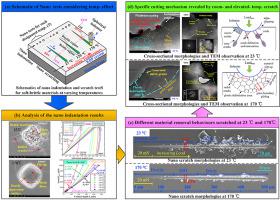International Journal of Machine Tools and Manufacture ( IF 14.0 ) Pub Date : 2020-08-24 , DOI: 10.1016/j.ijmachtools.2020.103620 Qi Liu , Zhirong Liao , Dragos Axinte

|
Soft-brittle crystals, e.g. KH2PO4 (KDP), are difficult-to-cut due to their high brittleness which can easily generate crack during the machining process. The conventional method to machine this kind of material is by inducing ductile cutting mechanism at room temperature with ultra-precision machining, which can only remove materials at nanoscale level and hence yields very low material removal rate. While some thermal-assisted processes have been recently attempted to improve the machinability of some difficult-to-cut materials, e.g. ceramics, there is no systematic understanding of the temperature effect on material removal mechanism of soft-brittle KDP crystals yet. In this work, the temperature effect on the material removal mechanism has been investigated for the first time using nano-scratch technique. While a decreased hardness and elastic modulus have been observed with the increase of temperature, an increase of fracture toughness has been revealed with a contradictory tendency, indicating a higher capacity of plastic deformation at elevated temperature. In contrast to the almost totally brittle scratch at room temperature (RT) caused by crack propagation and edge chipping, the scratch at 170 °C can achieve more ductile-regime surfaces with a larger critical undeformed cutting depth (3.61 μm), e.g. a significant increase of 8.60 times compared with that at RT (0.42 μm). Moreover, the TEM analysis on the subsurface microstructures shows that a great number of nano grits was generated in the subsurface at RT as the result of crack propagation and interaction, while at elevated temperature some crystallographic lattice misaligned structures (LMS) and nano crystals have been brought about due to the nucleation and evolution of thermal-activated dislocations, which explains the higher plasticity of KDP at elevated temperature. The results present in this paper are of great significance for understanding the specific temperature effect on the brittle-to-ductile transition of the cutting mechanism for future designing thermal-involved processes to machine soft-brittle materials.
中文翻译:

温度对纳米/微米级软脆晶体材料去除机理的影响
软质脆性晶体,例如KH 2 PO 4(KDP)因其高脆性而难以切割,在加工过程中容易产生裂纹。加工此类材料的常规方法是通过在室温下利用超精密加工诱导延展性切割机制,这种切割机制只能去除纳米级的材料,因此材料去除率非常低。尽管最近尝试了一些热辅助工艺来改善某些难切削材料(例如陶瓷)的可加工性,但尚未系统地认识到温度对软性脆性KDP晶体材料去除机理的影响。在这项工作中,首次使用纳米划痕技术研究了温度对材料去除机理的影响。虽然随着温度的升高观察到硬度和弹性模量降低,但显示出断裂韧性的升高具有相反的趋势,这表明在高温下具有更高的塑性变形能力。与在室温(RT)下几乎完全由裂纹扩展和边缘碎裂引起的刮擦相比,在170°C的刮擦可以实现具有更大的临界未变形切削深度(3.61μm)的更多的延展性表面,例如与室温(0.42μm)相比提高了8.60倍。此外,对地下微观结构的TEM分析表明,由于裂纹的扩展和相互作用,RT下的地下产生了大量纳米砂,而在高温下,由于热激活位错的形核和演化,导致了一些晶格失配结构(LMS)和纳米晶体的出现,这说明了高温下KDP的可塑性更高。本文的结果对于理解切削机构的脆性-延性转变的特定温度影响,对于将来设计热脆性材料加工软脆性材料的过程具有重要意义。











































 京公网安备 11010802027423号
京公网安备 11010802027423号